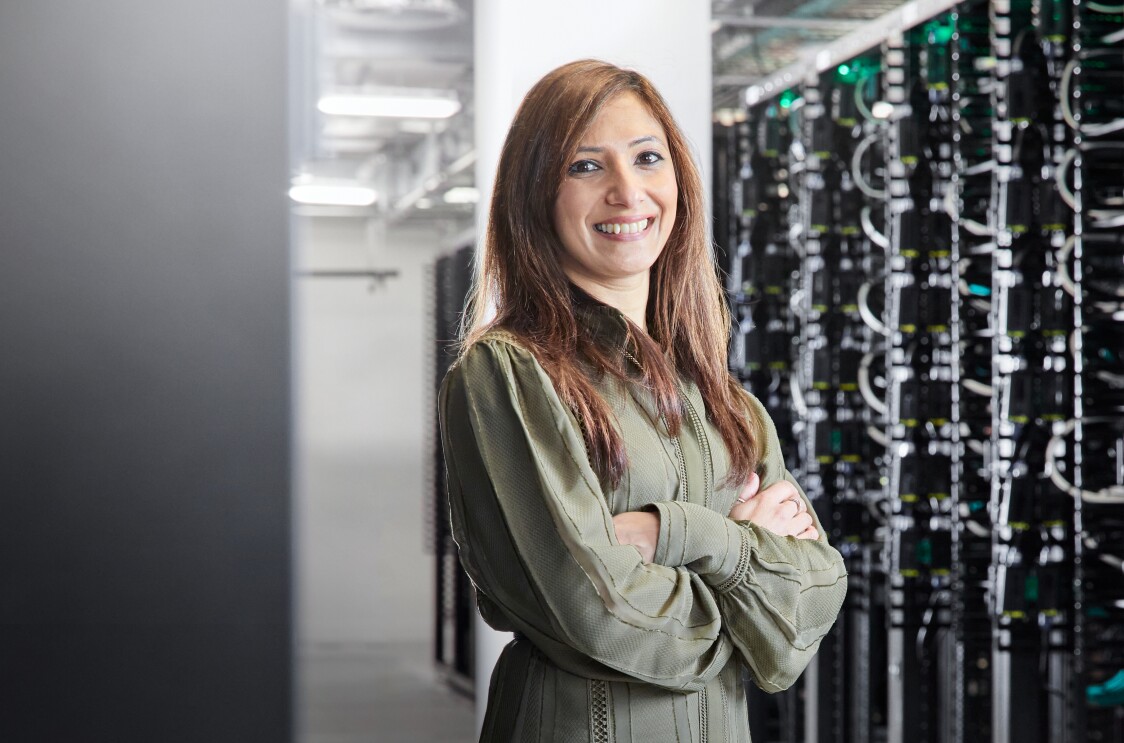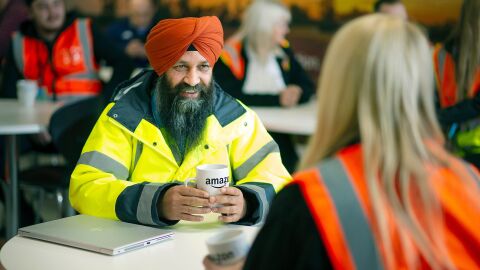At Amazon, we pride ourselves on inventing and building technology that delights our customers and pushes boundaries. The reason we can continue to do this is down to the talented technical people we hire and develop.
To find out more about landing a tech job at Amazon, and what it’s like once you are in one, we sat down with Tom Maddox, Head of UK SMB Solutions Architecture at Amazon Web Services (AWS), and Kam Bancil, a Software Development Manager at Amazon Prime Video.
Why build your tech career at Amazon?
Kam Bancil (Prime Video): Working in a technical role at Amazon makes you feel like you’re working on the edge of invention every day. Name a tech job, and that position is likely to exist at Amazon or AWS! This variety means it’s a great place to grow your career. From engineering and data science to management and product roles, you can build on a specific area you’re passionate about, or just as easily find opportunities here for lateral career moves.
For example, I’ve seen engineers progress from a graduate engineering or software development role and grow over the years into a leadership role, or even a VP position. I have gone through some lateral career moves myself. I first joined Amazon Prime as a Quality Assurance (QA) Manager, which involved developing, implementing, and maintaining a system of quality testing across our Prime Video app. Then I transitioned to a Senior Technical Programme Manager role, where I would work with stakeholders from different areas of expertise in Amazon (such as finance, marketing, operations, hardware and software) to bring a product or feature from concept to launch. Currently I’m in a Software Development Manager role where I lead a team of incredible engineers.
Working in a technical role at Amazon also means you are shaping customers’ everyday lives. My team consists of software development engineers, system engineers and support engineers responsible for building software tools that allow application developers who are working on new features to run automated tests and validate the quality of the software they are building for the majority of devices, at any time, from anywhere in the world.
Everyday we work with over 600 types of devices, such as smart TVs, games consoles and connected devices to ensure that customers can use Prime Video smoothly on these devices in their homes. I love telling people about my job, even though it’s technical they are always excited by it. I think because the technology lives in most people’s homes, they relate personally to it!

Right now, we’re focusing on live content and events, like major tennis tournaments and Premier League football. When you stream a live event, it’s critical to achieve ‘minimal latency’ for the best viewing experience possible. This means that there should be a relatively small time delay between the live event and the video stream which viewers see, even on the most low-powered device. Our engineers will work to achieve minimal latency for any Prime Video live event so it can be streamed from anywhere in the world across the majority of devices, ensuring that all customers can enjoy a seamless and consistent experience.
Tom Maddox (AWS): At AWS, we support organisations in the UK across every industry and of every size – from the fastest-growing start-ups, largest enterprises and leading government agencies. We provide them with secure, scalable, reliable, and cost-effective cloud services, which enable them to be more agile and lower costs.
My current job is to lead a diverse team of solutions architects who love being on the cutting edge of cloud technology every day. Our role is to give the best technical advice to our small business customers across all industries in the UK, helping them to turn their growth ambitions into real capabilities using cloud computing.
I think data and machine learning are two of the most exciting areas for a technical person to get involved with at AWS today.
One customer we have helped is the roadside assistance company Green Flag, which offers 24/7 roadside assistance services to its 3.5 million users. Green Flag wanted to move away from its legacy system and adopt serverless solutions using AWS. Fast forward to today and the company has significantly improved the functionality and speed of its mobile application, website, and overall technology environment.
By going serverless on AWS, Green Flag now has the flexibility and scale it needs to handle unforeseen fluctuations in demand and quickly respond to drivers who need assistance, at any time and at any location in Europe, enabling the company to rescue an average of 2,000 vehicles per day.
I will never get tired of helping a business derive actionable, business insights from data and understand what they can achieve with the right systems. Working for a company like AWS means I can empower entrepreneurs and business owners with the tools and expertise needed to grow their ambitions.
Amazon is also a great place to make the move from a non-technical role to a technical role. I’ve seen this a few times. In general, there aren’t many barriers to moving jobs at Amazon. Sometimes, we see individuals join Amazon in an entry level position for a non-technical focused role who have technical degrees, and some just have hobbyist experience with technology. Often these people will make themselves and their interest in technology known, and we can create opportunities and a development plan for them. This might include shadowing technical teams to start with, and providing tailored suggestions for independent learning and studying.
There are lots of routes into a tech career at Amazon, especially jobs in emerging technologies like Internet of Things (IoT) for our connected products, robotics at our fulfilment centres, data science to help make Alexa smarter and advanced data analytics to personalise and improve the shopping experience for our customers. Amazon is a data driven company, and we put a lot of value in these types of roles.
![Amazon_Portraits_Tom_Maddox_22[2].jpg working at Amazon](https://assets.aboutamazon.com/dims4/default/b769336/2147483647/strip/true/crop/6361x4241+0+0/resize/1114x743!/quality/90/?url=https%3A%2F%2Famazon-blogs-brightspot.s3.amazonaws.com%2Fe7%2F40%2F42fe28f9403d823763352cfa3734%2Famazon-portraits-tom-maddox-222.jpg)
Insights on interviewing for a tech role
KB: The process for tech and engineering roles starts with CV screening and continues with an online assessment, which is a coding exercise approved through a software tool. Then, if successful, you enter the interview stage. Typically, there are four or five interviews in one day, and the candidate is evaluated against Amazon’s leadership principles and on their technical competency.
For an engineering role specifically, we want to see a candidate’s problem-solving skills. We will set a computing task and ask the individual to break down the problem and talk us through their approach. This demonstrates their knowledge of computer science fundamentals to us.
TM: All candidates applying for a role at Amazon will be asked to take part in several behavioural interviews, and this is true for tech roles, too. However, tech candidates will also go through specific tech assessments, and these will vary depending on the type of role. Some of the most common technical roles at Amazon include solutions architects, data scientists and software development engineers. These all require a slightly different recruitment process to find the right talent for the job.
Thinking of my organisation, when interviewing a candidate, we’re not only looking at their technical skills; we also want to know if they have really strong communication skills and business acumen. They need to show both their technical depth and breadth – a depth of knowledge and skills in one or two technical domains – but also an awareness and general understanding across a breadth of other areas. This might indicate to us a candidate’s potential for learning quickly in new technical fields.
For tech roles specifically, Amazon uses online assessments, and for solutions architect roles we might even do a whiteboard session as one of the interview stages. The online assessment could be a troubleshooting task, and the interviewers who are technically skilled will inspect the work to assess the candidate’s experience and skills. When whiteboarding, we’re looking for how competently technical concepts can be explained – and how an architecture can be tailored to a specific business’ need. Otherwise, the timeline for interviewing is nearly the same for non-technical roles at Amazon.
A unique culture for tech and innovation
KB: There are lots of unique functions that we use to cultivate and maintain the Amazon culture for technology and innovation, and these create a fabulous work environment where our technical employees can continue learning and growing.
One is the ‘working backwards’ approach. This means that if you have an idea, you start with the end point of where you want to be, and then work backwards from there. A typical exercise would be writing a press release, including what you think might be the frequently asked questions about the end product or service.
The result is that your final idea makes sense to stakeholders internally and customers externally, and then you work out the details from there. It’s very powerful!
This mindset is in the Amazon DNA. Jeff Bezos has always talked about failing early and spending time iterating until we get it right. When this process works, it means our failures are relatively small, and when we get it right, we can double-down on it with hopes to turn it into an even bigger success.
TM: In both technical roles and non-technical roles, every day at work is Day One at Amazon. It might sound cheesy, but we really live this motto. There will always be something new our customers need from us, and new problems to solve. If we stopped listening to customers and constantly reprioritising and re-evaluating what we do, we wouldn’t be able to invent products and services that transform the way our customers interact with the world.

Explore technical roles at Amazon.


![EU_Amazon_Portraits_Kam_Bancil_7[1].jpg Working at Amazon](https://assets.aboutamazon.com/dims4/default/739f957/2147483647/strip/true/crop/6385x3594+0+331/resize/1240x698!/quality/90/?url=https%3A%2F%2Famazon-blogs-brightspot.s3.amazonaws.com%2F01%2Fa9%2F046d2f974cbda5b4d83e2513856d%2Feu-amazon-portraits-kam-bancil-71.jpg)










